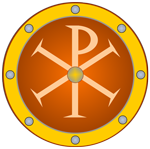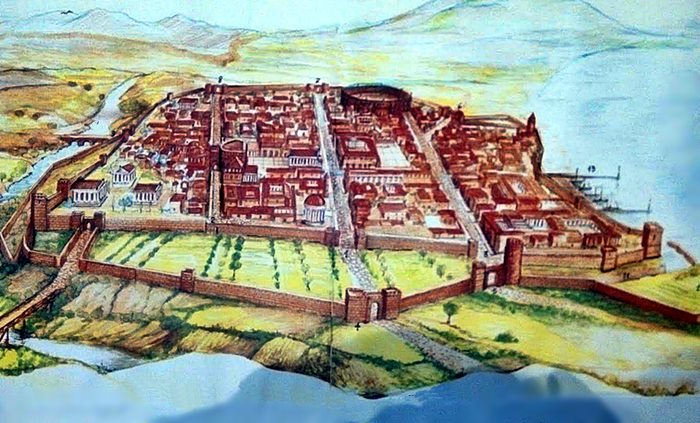
Siege of Naples |
year: 536November 536 |
| Siege and capture of Naples by the army of Belisarius | ★ ★ ★ ★ ★ |
|
enemy: Ostrogoths
|
location: Naples, Italy
|
accuracy:
●●●●●
|
|
battle type: City Capture |
war: Gothic War in Italy |
modern country:
Italy |
| ▼ The Byzantines(emperor: Justinian I) | ▼ The Enemies | |
| Commander: | Belisarius | Unknown |
| Forces: | <8.000 | |
| Losses: |
| Background story: |
| After the fast overthrow of the kingdom of the Vandals in North Africa, Emperor Justinian decided to attack the kingdom of the Ostrogoths in Italy on the pretext of the imprisonment and assassination of the queen of the Ostrogoths Amalaswintha by her cousin and co-ruler king Theodahad (or Theodatus). Thus, at the beginning of 535, Byzantine forces invaded Italy. Belisarius attacked Sicily, while magister militum per Illyricum Mundus from Dalmatia invaded northern Italy with 4,000 men. Belisarius landed in Catania. The full powers of imperator were again conferred upon him. But his army, this time, was hardly half as strong as that which he had led against the Vandals. It consisted of 4000 legionaries and Federates; a special division of 3000 Isaurians under Eunes; 200 Huns, 300 Moors; and the armed retainers of Belisarius, who may have amounted to several hundreds. Thus the total strength was about 8,000, which together with the fleet should amount to about 12,000. In Sicily, the Byzantines did not encounter any particular difficulties except for a small resistance in Panormon (Palermo). The island was conquered within a few months, although Belisarius delayed a little, because he had to go back to Carthage where the army had revolted. After restoring order there, he returned to Sicily in mid-536 and crossed with his army to mainland Italy. He crossed Calabria and Campania unhindered and reached Naples, which was guarded by a strong Gothic guard. Here in Naples, Belisarius met the first serious resistance during his campaign. It was mid-October 536. The fleet blocked the port and the coast, while Belisarius encamped outside the city, where he received a deputation of citizens, who implored him not to press them to surrender; Naples is a place of no importance, they said, let him pass on and take Rome. The general, observing that he had not asked them for advice, promised that the Gothic garrison would be allowed to depart unharmed, and he privately promised large rewards to Stephen, the head of the deputation, if he could prevail upon the citizens to surrender. An assembly was held in the city and at first most agreed to a conditional surrender. However, two orators intervened, Pastor and Asclepiodotus, and with great eloquence convinced the others that there was no reason to surrender. Their main argument was that the city was insignificant and the Greeks would not want to delay there, so they would leave soon anyway, while Naples would have taken an honest stance in the eyes of the world, regardless of who would prevail at the end of the war. In addition, King Theodotus of Ostrogoth would certainly send an army to help them. Adopting this view, the Neapolitans refused to surrender. Belisarius did not want to advance on Rome leaving behind an enemy fortress that, despite the rhetoric of the Neapolitans, was strong and important. |
The Battle: |
 depiction of Naples in the beginning of Middle Ages Having wasted some weeks and incurred serious losses in men, Belisarius, impatient to advance against Rome, decided to abandon the siege. But the luck was again with him. He had given orders to the army to prepare for departure, when a curious Isaurian soldier, climbing into the broken aqueduct in order to inspect its construction, discovered that, near the walls, the channel had been pierced through solid rock. The aperture was still open. Without water, it was just a tunnel under the walls of the city. The hole was too small for a man in armor to pass, but it could be easily enlarged. Belisarius was very excited and ordered the widening of the hole. Files were employed to scrap the rock, so as to make no noise. When the opening was ready, the general gave the Neapolitans a last chance to avoid bloodshed and the horrors of a sack. He summoned Stephen to his camp, assured him that it was now impossible that the city should not fall into his hands, and implored him to persuade his fellow-citizens to capitulate and avoid the miseries which would befall them. Stephen returned in tears, but the people refused to listen. They were convinced that the appeal of Belisarius was merely a ruse. Six hundred men crept through the aqueduct at night, and reached a well in the basement of a house deep in the city. They got out and slew the sentinels on the northern wall, and enabled the Roman troops who were waiting below with scaling-ladders to ascend on the battlements. The horrors which Belisarius had anticipated ensued, and the Huns particularly distinguished themselves in the work of murder and plunder. At the end, the general succeeded in gathering the troops together and stopping the carnage. Swords were sheathed and captives were released. Eight hundred Goths who were taken were well treated. The Neapolitans turned with anger against the two demagogues whom they held responsible for all that had befallen them. They slew Asclepiodotus; they found Pastor already dead, stricken by apoplexy when he knew that the city was taken. Naples fell in early November 536. The siege lasted 20 days. |
Aftermath: |
| The fall of Naples shocked the Goths. The inaction shown by their king Theudatos was unacceptable. The enraged Ostrogoth warlords elected another king, Vitiges. Theudatos, who was in Rome, tried to flee to Ravenna, but was killed on the way by order of the new king. Belisarius marched against Rome, which Vitiges abandoned on the pretext that he had to fight the Franks at the north of the country. Rome was taken without a fight… |
|
|
